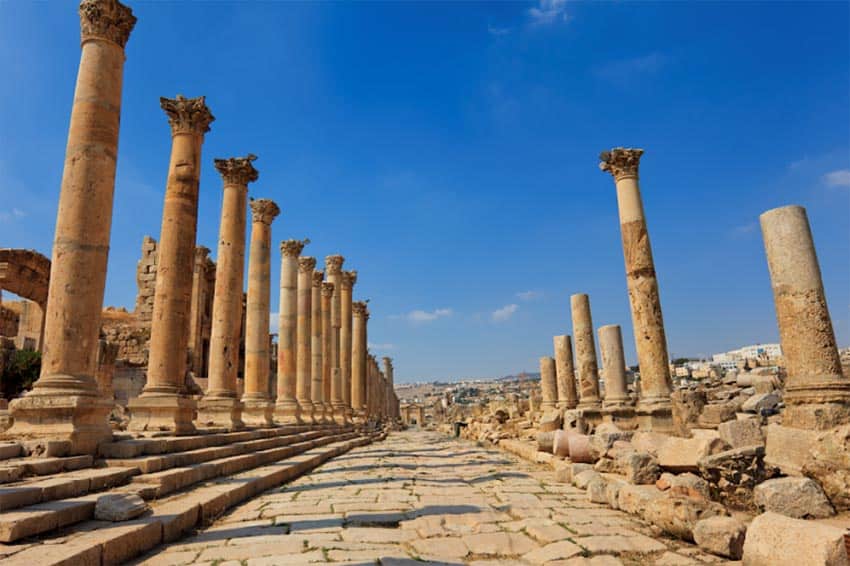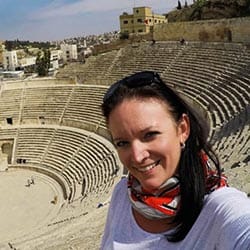
Who Needs Rome When you can visit Jordan’s Jerash?
By Lindsay Nieminen
It was hot. Clothing-sticking-to-your-body hot. But I was not going to let that deter me from exploring the ancient colonnaded streets of Jerash, the best-preserved Roman city outside of Rome and located less than an hour’s drive north of Amman, the capital city of Jordan.

While thousands of visitors flock to the red rose city of Petra or visit Mount Nebo on a quick religious stop in the country, many do not stay in Jordan long enough to explore one of the most impressive remains of the Roman Decapolis, Jerash.
Known in Roman times are Gerasia, Jerash is a worthwhile stop in any Jordan Itinerary, as you do not just see a small ruined site, it is an entire city that you can walk through, and its state of preservation is amazing.
Hadrian’s Arch
Enter Jerash from the south via Hadrian’s Arch and you get a glimpse of what was once a bustling city.

The arch, a 13 meter high, triple arch, was built in 129 AD to commemorate the visit of the Roman Emperor Hadrian.
It is comprised of a main central arch, and two smaller arches flanking each side. At one time, huge wooden doors would have hung under the main arch.
After a drink of water under the shade of Hadrian’s Arch, I continued to the Forum Cardo. The oval forum was only recently discovered in 1970 by Jordanian Army forces, who were setting up tents in what was an ideal campsite, a flat location in an area full of hills.
It is an impressive sight not only because of its sheer size, but because of its design of limestone laden stones, getting larger as you move away from the center of the oval and, its 56 corinthian, honey-colored columns, decorated with acanthus leaves and scrolls.
This discovery of the oval forum became one of Jerash’s hi-lights, as the forum once served as a marketplace and was the center of social and political life for the residents of Gerasia.
Walking through the giant forum, I imagined peddlers selling their wares, woman gossiping about local news, and announcements being made above the bustling noise of a vibrant city.
Despite its status as a Roman city, the columns in the oval forum were carved in the Greek style.
Beyond the Forum Cardo lies the Cardo Maximus, a once flat colonnaded street which is now bumpy and wavy on account of the

earthquakes that once rattled the region. While I walked towards the Northern Gate of the city, a close examination of the stones bears marks from wheeled carts.
The stones lay in such a way that the carts would not bump over each stone, but could travel smoothly across the road.
The Cardo Maximus was built in the 1st century AD and included manholes and allowed for underground drainage. The level of sophistication in 2000-year-old structures still amazes me.
It is intersected by the East-West running Decumanus, noted by the remains of four towers, one on each corner of the intersection.
As I continue along the Cardo Maximus, barren stalls on either side of the street were once full of goods for sale, as shopkeepers supplied this buzzing city with goods.
Plenty of Roman structures lie on either side of the street, from the cathedral entrance, western baths and the Nymphaeum, the main fountain in Jerash.

The Nymphaeum
The Nymphaeum is a huge two-story structure, which once had a half-dome roof. During its glory, water cascaded from the heads of seven carved lions into a basin on the street below.
It gives clues to what the ancient city looked like, as some original plaster and paint still remain on the upper level of the fountain. The entire city was once ornately painted, yet only small remnants exist to show how it once was.
When I emerged to see the South Theatre, its size took my breath away. And well, standing on the edge of an ancient theatre with rough crumbling rock edges is a little terrifying as well.
I was careful as I climbed up to the top, taking a view from one of the best seats in the house at the colorful stage below. Built between 81 and 96 AD, this 2000-year-old theatre once sat over 5000 spectators.
Now empty, but remarkably preserved, it is easy to imagine what it would have been like to see the residents of this city seated in the theatre.
Wandering to the highest point of Jerash, I gazed over at Zeus’ Temple. Intricate and delicate greek carvings amongst massive blocks are still prominent in this religious site. Fifteen churches also lie in the historic site of Jerash.
When Christianly became the official religion in the Empire, churches and cathedrals became the priority, as cities competed to build elaborate structures. Mosaic’s of animals, grape leaves, olive trees and daily life for the Romans can still be seen in Jerash today.
Grassia was a bustling Roman City, its importance, in part due to the rich soil in the region and its ideal climate for growing fruits and vegetables. In the 3rd century AD, it is estimated that its population boasted 15000 to 20000 inhabitants.
The city is also home to a second temple, the Artemis Temple, two hammams and a second theatre which now has daily shows reenacting some of the Roman entertainment that would have existed in Gerasia.

An earthquake in 747 AD caused the initial decline of the city, and it eventually because deserted for many centuries, with only brief occupation by the crusaders in the 12th century. Despite Jerash’s grandeur, it is not UNESCO protected.
This is because the inhabitants of modern-day Jerash have built their homes and their businesses within the ancient city walls and it is impossible to move a whole city out of an ancient Roman site. The current population of Jerash is over 50 000 people.
While the hot Middle East sun beat down on my shoulders as I walked away from the oval forum, I could still imagine the Roman inhabitants of Gerasia filling the streets and the forums of this once bustling city. I am glad that I did not rush to Petra and skip Jerash.
It is well worth a visit and I feel now that I understand so much more about the Roman Empire without yet having visited Rome and competing with the 4 million annual visitors to that city. In comparison, Jerash receives less than 200 000 visitors annually and on some days, like the day I visited, you can have most of the site to yourself.
Things to Know:
Despite its location in the Middle East, Jordan is known as a safe destination. You can read more information on Safety in Jordan on my website, Carpe Diem Our Way.
Jerash is located 50 kilometers north of Amman

Entrance to Jerash costs JD10 (USD14) and local guides are JD25 (USD 35) If you have a Jordan Pass, entrance is included in the pass
For an additional fee, there is a daily scheduled show lasting about 30 minutes, reenacting a typical Roman performance from the second century. Check on arrival for the cost and showtimes.
A taxi From Amman for the day will cost around USD100-150. You are better off renting a car.
Expect to spend 3-4 hours at the site.
Bring plenty of water, as there is little shade.
Snack Shops and Toilets are available on site.
In the winter and spring months temperatures can be cool, around 10 degrees Celsius and in the summer and early fall, the daily high will likely be 30 degrees Celsius.

Lindsay Nieminen hails from Vancouver, Canada but has discovered she loves being a foreigner. Besides freelance writing, she shares her love of travel on her adventurous family travel blog Carpe Diem OUR Way and is passionate about showing others that they should not put off traveling the world just because they have young children or are single parents. She aims to encourage them to seek out adventure, whether it is at home or abroad by providing information on how just about everywhere can be a destination to explore as a family.
- These 9 U.S. National Parks Require Reservations in 2024 - April 17, 2024
- Take a Hike in Olympic National Park - April 17, 2024
- The Wild Mississippi: 2340 Miles Across Ten States - April 8, 2024



Hey Nieminen, Thanks for sharing the experience. You have done a great job by posting the pictures, in which I have liked the place of “The North Theatre in Jerash” very much.
I have been in Saudi a year ago and visited many places but not Jordan…thanks for the great info…Felt so happy to know great history of Jordan….On my next business visit, Definitely, i would not miss to checkin Jerash. And i suggest to all the travellers who wish to visit Jordan, you can book tickets at better fares by booking at Tajawal.